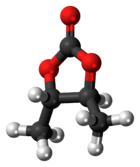trans-2,3-Butylene carbonate
Appearance

| |

| |
| Names | |
|---|---|
| IUPAC name
trans-4,5-Dimethyl-[1,3]dioxolan-2-one
| |
| Identifiers | |
| |
3D model (JSmol)
|
|
| ChemSpider | |
PubChem CID
|
|
| UNII | |
CompTox Dashboard (EPA)
|
|
| |
| |
| Properties | |
| C5H8O3 | |
| Molar mass | 116.116 g·mol−1 |
Except where otherwise noted, data are given for materials in their standard state (at 25 °C [77 °F], 100 kPa).
| |
trans-2,3-Butylene carbonate is an organic compound with formula C
5H
8O
3, or (H3C)2(C2H2)(CO3). It is an ester with a carbonate functional group bonded to both free ends of the trans-2,3-butylene group. It is also a heterocyclic compound with a five-membered ring containing two oxygen atoms, and can be viewed as a derivative of dioxolane, namely trans-4,5-dimethyl-1,3-dioxolan-2-one.
The compound is an aprotic polar solvent and has been proposed as an ingredient of the electrolyte of lithium batteries.[1]
See also
[edit]References
[edit]- ^ Geun-Chang Chung, Hyeong-Jin Kim, Song-Hui Jun and Myung-Hwan Kim (1999), New cyclic carbonate solvent for lithium ion batteries: trans-2,3-butylene carbonate. Electrochemistry Communications, volume 1, issue 10, pages 493-496. doi:10.1016/S1388-2481(99)00101-0
